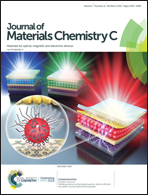Unconventional dihydrogen-bond interaction induced cyanide-bridged chiral nano-sized magnetic molecular wheel: synthesis, crystal structure and systematic theoretical magnetism investigation†
Abstract
A pair of cyanide-bridged 4d–3d heterobimetallic chiral macrocyclic enantiomeric magnetic complexes have been successfully assembled from the trans-dicyanoruthenium(III) building block [PPh4][Ru(Salen)(CN)2] (Salen = N,N-ethylenebis(salicylideneaminato)dianion) and [Mn((S,S/R,R)-Salcy)(H2O)2]ClO4 (Salcy = N,N′-(1,2-cyclohexanediylethylene)bis(salicylideneiminato)dianion) with the great help of the dihydrogen bond (DHB) interaction and characterized by elemental analysis, IR spectroscopy, circular dichroism (CD) and magnetic circular dichroism (MCD) spectroscopy. Single X-ray diffraction reveals that complex 1, {[Ru(Salen)(CN)2][R,R-Mn(Salcy)]}6·PPh3·6CH3CN·6CH3OH·12H2O, is a neutral dodecanuclear cluster containing a 36-membered macrocycle with the cyclohexane-like configuration comprising alternative [Ru(Salen)(CN)2]− anions and [Mn(Salcy)]+ cations, which is the first cyanide-bridged 4d–3d metallic-based nano-sized chiral magnetic molecular wheel compound. A detailed magnetism study on the chiral macrocyclic complex, revealing the single molecular magnet (SMM) characteristic and the magnetic coupling nature between the Ru(III) and Mn(III) ion, as well as the magneto-structural correlation, has been systematically theoretically investigated based on the newly developed effective spin hamiltonians, which can provide valuable information for the rational design of single-molecule magnets by controlling both the nature of the magnetic couplings and the spin ground state.



 Please wait while we load your content...
Please wait while we load your content...